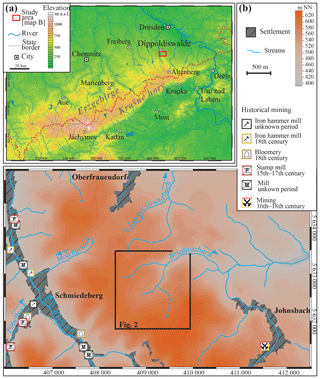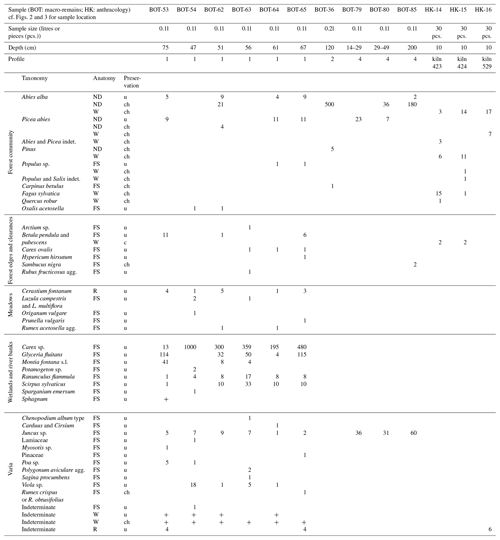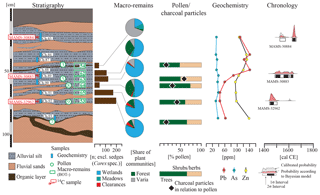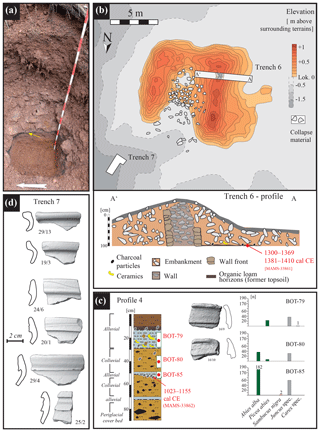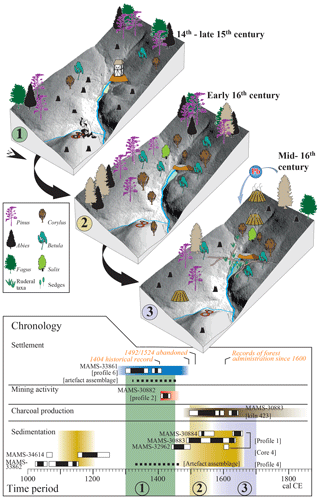Fortification, mining, and charcoal production: landscape history at the abandoned medieval settlement of Hohenwalde at the Faule Pfütze (Saxony, Eastern Ore Mountains)
Geoarchaeological reconstructions of land-use changes may help to reveal driving cultural factors and incentives behind these processes and relate them to supra-regional economic and political developments. This is particularly true in the context of complete abandonment of a settlement. Here we present a case study from the site of Faule Pfütze, a small catchment in the Eastern Ore Mountains (Saxony). The historical record of this site is confined to the report of a settlement called Hohenwalde in 1404 CE and two later references to the then-abandoned settlement in 1492 and 1524 CE in this area. Combined geoarchaeological studies allowed for the reconstruction of several phases of land use. While a first phase of alluvial sedimentation occurred during the late 12th century, archaeological evidence for a permanent settlement is absent during this period. The onset of settlement activity is identified during the late 14th century and included a hitherto unknown massive stone building. Mining features are present nearby and are dated to the early 15th century. The local palynological record shows evidence for reforestation during the mid 15th century and thereby corroborates the time of abandonment indicated by written sources. These processes are discussed in the context of a local political conflict (Dohna Feud) leading to the redistribution of properties and the development of a mining economy during this time. Later land use from the mid 16th century onwards appears restricted to charcoal production, probably in the context of smelting works operating in nearby Schmiedeberg as indicated by rising lead concentrations in the alluvial record.
Geoarchäologische Rekonstruktionen der Landschaftsgeschichte können dazu dienen, die hinter diesen Prozessen liegenden kulturellen Triebkräfte und Motivationen offenzulegen und diese mit überregionalen ökonomischen und politischen Entwicklungen in Beziehung zu setzen. In besonders hohem Maße trifft dieses im Umfeld von vollständigen Wüstungsprozessen zu. Im Rahmen einer Fallstudie wird hier die Fundstelle an der “Faulen Pfütze”, einer kleinen Siedlungskammer im Osterzgebirge (Sachsen), vorgestellt. Die historische Überlieferung zu dieser Fundstelle beschränkt sich auf die Nennung einer Siedlung “Hohenwalde” im Jahr 1404 sowie zwei spätere Nennungen aus dem Jahr 1492 und 1524, die sich bereits auf eine Wüstung in diesem Gebiet beziehen. Nur durch geoarchäologische Ansätze war es daher möglich, unterschiedliche Phasen der Landnutzungsgeschichte zu rekonstruieren. Während eine erste Phase der alluvialen Sedimentation bereits im späten 12. Jahrhundert festzustellen ist, fehlen archäologische Belege für eine dauerhafte Siedlung zu diesem Zeitpunkt noch völlig. Der Beginn der Siedlungsaktivitäten setzt im späten 14. Jahrhundert ein und umfasst dabei auch ein bislang unbekanntes massives Steingebäude. In unmittelbarer Nähe treten Bergbauspuren auf, die in das frühe 15. Jahrhundert datieren. Die palynologischen Analysen zeigen eine lokale Wiederbewaldungsdynamik ab der Mitte des 15. Jahrhunderts und bestätigen dabei den durch historische Quellen genannten Zeitpunkt der Siedlungsaufgabe. Diese Entwicklung wird vor dem Hintergrund eine regionalen Auseinandersetzung (Dohnaischen Fehde) diskutiert, die vor Ort nicht nur eine territoriale Neuverteilung sondern auch Bergbauaktivitäten zur Folge hatte. Spätere Landnutzung ab der Mitte des 16. Jahrhunderts scheint dann auf die Produktion von Holzkohle beschränkt gewesen zu sein, wahrscheinlich zur Versorgung der Hüttenwerke im nahen Schmiedeberg, was sich auch in steigenden Bleieinträgen in den alluvialen Sedimenten abzeichnet.






